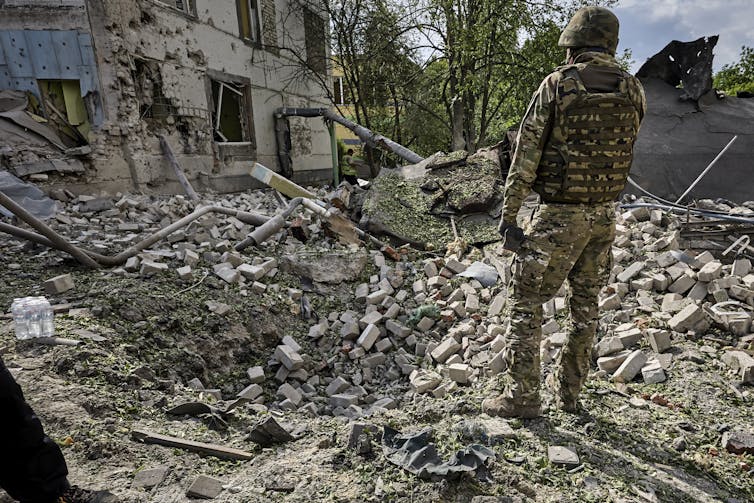As Ukraine fights against Russian invasion, it faces a battle on two fronts: military and financial. Global attention understandably focuses on battlefield developments, where Russian troops are pushing towards Ukraine’s second city, Kharkiv. But Ukraine is simultaneously experiencing financial struggles.
With its economy damaged by war and the year’s defence cost estimated to be £35 billion, Ukraine is on the brink of defaulting on £18 billion in debt. For Ukraine, debt is not an accounting exercise – it represents the ability to defend its sovereignty and secure its future.
At the onset of the war, private investors led by JP Morgan agreed to freeze Ukraine’s debt repayments. That agreement is set to expire in August. Both Ukraine and its lenders are racing to reach a last-minute debt deal to avoid default.
These debt restructuring talks are common between states and investors, but they usually last years and rarely occur in the context of war. At present, both sides remain far apart in their negotiations. Ukraine is demanding a 40% reduction in its debt obligations and investors are willing to take only a 20% loss – known in financial circles as a “haircut”.
Ukraine faces a trade-off in its debt negotiations. On the one hand, securing a larger debt reduction, or even an outright default, could free up substantial fiscal resources in the short term. This would allow Ukraine to redirect funds from debt payments to immediate war-related needs.
However, the long-term consequences of such a decision could be severe, with higher borrowing costs and longer periods of exclusion from capital markets. The outcome of these negotiations will shape not only Ukraine’s immediate defence capabilities but also its long-term economic resilience.

A country’s ability to access credit markets plays an important role in determining the outcome of a war. In previous research, which was published in 2013, I found that states with lower borrowing costs are significantly more likely to win their wars.
Debt allows states to mobilise more resources, more quickly than they otherwise could. The cheaper the debt and the easier it is to access, the more resources that country can mobilise for its war effort.
Because of the importance of debt for war, states involved in wars rarely default. The risk of losing access to credit markets is usually too high. There are, however, some notable exceptions.
Russia technically defaulted on its debt shortly after its invasion of Ukraine in 2022 because sanctions made it impossible to make debt payments. And Saddam Hussein’s Iraq defaulted amid the war between Iran and Iraq in the 1980s. But both countries had substantial natural resource wealth to draw upon, a luxury Ukraine doesn’t have.
The Russian and Iraq exceptions highlight another crucial factor in wartime finance: the nature of a country’s political system. As autocracies, Putin’s Russia and Saddam’s Iraq could impose restrictive economic measures during wartime. The Russian government, for example, has imposed controls that make it difficult for exporters and foreign companies operating in the country to take money out of Russia.
By contrast, the Ukrainian government has to be sensitive to the domestic political pressures of war financing. Measures like those adopted in Russia would probably spark political discontent in Ukraine.
Debt allows democracy leaders to mobilise resources without relying on unpopular fiscal strategies. However, facing the prospect of reduced access to debt, Ukraine has reverted to divisive tax policies that have raised the tax burden on individuals while cutting social spending.
Taxes are important to the war effort, but they risk upsetting the necessary domestic support to continue fighting. And the Ukrainian government has been accused by journalists and international watchdog groups of being too restrictive in its response to domestic discontent. The Ukrainian domestic intelligence agency allegedly surveilled an investigative media team in their hotel rooms.

Ukraine’s financial future
There’s some good news for Ukraine’s leadership though. After much delay, US Congress passed a military aid package worth US$60 billion (£47.4 billion) in the spring. At the same time, the UK provided its largest aid package to Ukraine, worth more than £3 billion for 2024.
More recently, the G7 (which consists of Canada, France, Germany, Italy, Japan, the UK and US) agreed to use Russia’s frozen assets to finance a new US$50 billion loan to Ukraine.
These additional financial resources are needed for Ukraine’s war effort. But they do not solve the immediate debt problems. The UK and US aid packages are earmarked for military equipment only and cannot be used for budgetary support. The G7 loan will be more flexible, but that money is not expected to be delivered until later this year.
Ukraine must balance the immediate needs of war financing with long-term economic considerations and domestic political pressures. The stakes could not be higher. The terms Ukraine secures in debt negotiations will affect not just its ability to fund the current war effort, but also its capacity to rebuild once the conflict ends.

